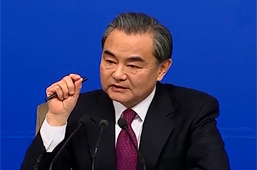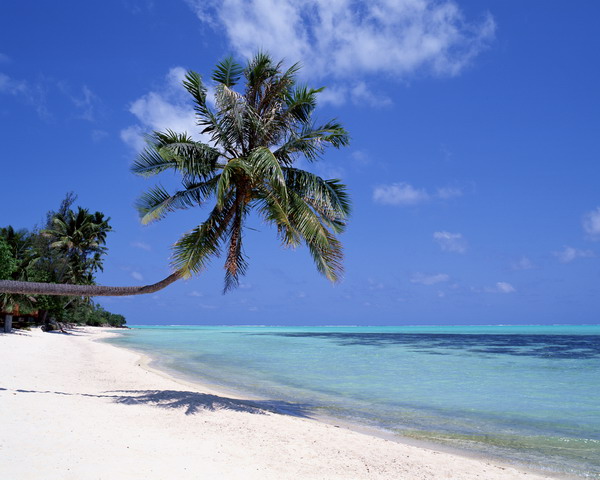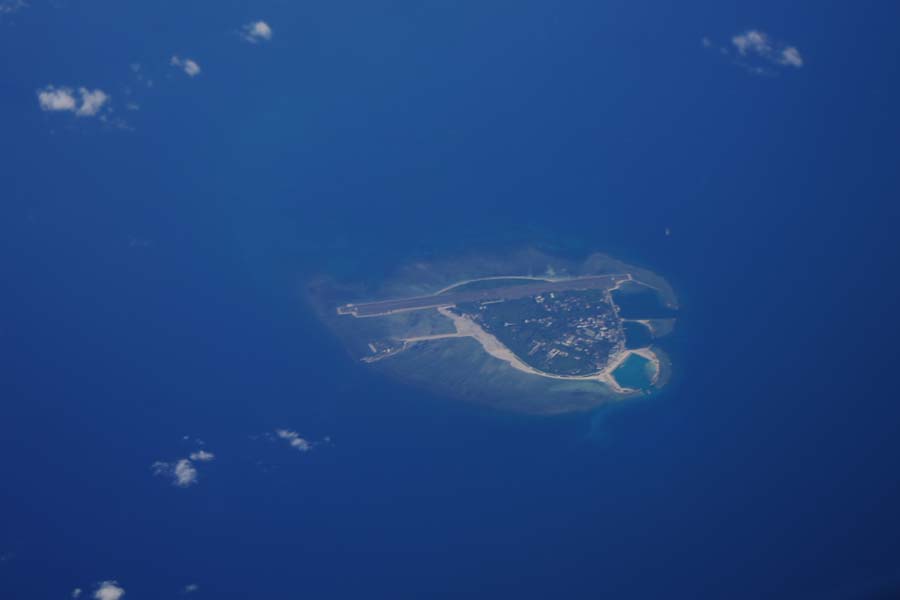3. The Diplomatic Struggles to Safeguard Chinese Sovereignty of Nanhai Zhudao
1) Negation on Foreign Invasion of the Sovereignty over Xisha Qundao
On January 6, 1932, the French Ministry of Foreign Affairs submitted an outline of its objections to the Chinese Embassy regarding China's sovereignty over Xisha Qundao, and claimed that their sovereignty "had always belonged to Annam." On April 29, the French Embassy in China again sent a diplomatic note to the Chinese Ministry of Foreign Affairs, expressing objection to the decision of Guangdong Province to promote investment for mining guano resources in Xisha Qundao.
On receiving the outline through the care of the Chinese Embassy in France on February 13, 1932, the Chinese Ministry of Foreign Affairs promptly started an investigation of Xisha Qundao. On July 26, 1932, it requested the Chinese Embassy in France to solemnly refute the claim of France to French Ministry of Foreign Affairs according to the pre-emptive and timeliness principles of international public law, and to offer six arguments, as follows: (1) In accordance with the provisions in the third point of the Interim Provisions of the Sino-French Treaty of 1887, the jurisdictions of Islands on the Sino-Vietnamese maritime border shall be determined on the basis of the line drawn southward from the boundary line between the two countries. Xisha Qundao (the Paracel Islands), located to the east of the line, shall belong to China. (2) In line with international law and conventions, effective pre-emption shall be the prerequisite for territorial sovereignty, while Chinese fishermen in Hainan have long been known to live and fish in Xisha Qundao. (3) Historically, mining and fishing activities on Xisha Qundao have been exclusively implemented by the people of Hainan. One hundred years ago, Annam was a vassal state of China, and could not have occupied the territory of its sovereignty. In addition, the record excerpted by the French was obviously far-fetched. There were no ruins of monuments erected by Vietnam on Xisha Qundao to testify that the Vietnamese had landed on any reef there. (4) In 1909, when Li Zhun the Chinese general went to the Xisha Qundao for investigation, he erected Chinese standard and fired guns, as a token of announcing sovereignty. Since the Republic of China, the Chinese government has repeatedly authorized enterprises to engage in reclamation activities in Xisha Qundao, indicating that China has had effective administration for those Islands. (5) At the Far East Observatory Conference held in Hong Kong in 1930, Annam and the director of the French Observatory in Xujiahui jointly proposed that the Chinese Government build an observatory in Xisha Qundao, indicating official recognition of the Chinese sovereignty by France. (6) The so-called protest by the British consul in 1898 cannot be corroborated in records and is thus unsound as evidence.
At the same time, the Ministry of Foreign Affairs immediately carried out relevant researches to justify China's sovereignty with historical evidence and international law theories and to refute Annam pre-emption claimed by France. On the one hand, it made proactive efforts to collect evidence, "with particular emphasis on administration of the Islands by the local government of Qiongdao, including related documents, books, maps, etc., and record of Chinese activities reported in French or other newspapers and magazines should be prioritized," to prove that China's sovereignty over Xisha Qundao has met the two requirements of international law (a) manifestation of intention and (b) the fact of occupation." Regarding the French point of view, "If its claim is only based on Record of Annam, we shall firstly seek to prove that its record is unreliable in that it is not an official instrument, secondly prove that, from the time when Vietnam was placed under French government till 1932, France has never claimed sovereignty over those Islands or occupied them, and thirdly prove that France voiced no objection to the claim of sovereignty over or administration of them. To the contrary, the Chinese government began to claim sovereignty from France in 1932 and protested when French troops occupied nine Islands there in 1938. This shall be passive preparations." After preparations from the above two aspects and comprehensive analysis of the so-called materials presented by France, the Chinese Ministry of Foreign Affairs pointed out that China boasted undisputed sovereignty over Xisha Qundao and that the reasons proposed by the French side were untenable from both the historical and legal perspective. Since Xisha Qundao was not territory without sovereignty, there would be no need for effective occupation, proclamation or other formalities. There were no permanent (but regular and seasonal) residents, but that was because of the hostile natural conditions, not forfeit of sovereignty. The announcement of Li in 1909, is to reaffirm a re-declaration of sovereignty, not one of occupation or annexation (therefore the annotation of "Annexed to China in 1909" in Map No. 94 by the British Navy should also be corrected).
Meanwhile, in the analysis and application of international law, Qiu Zuming, the first secretary of the rank of Counselor and acting director of general affairs of the Chinese Embassy in Turkey proposed that the Western international law could not be relied on as the self-evident standard for the issue of Xisha Qundao and Nansha Qundao. He cited the latest international jurisprudence and advocated using the approach of intertemporal laws to resolve the issue. He pointed out that the prevalent international law at the time of occupation should be used to analyze the sovereignty of Xisha Qundao. According to the official history and maps of China, Xisha Qundao had been under the government of Guangdong, and those facts occurred before the General Resolution of Berlin. Therefore, China had the legal sovereignty over the Xisha Qundao, without having to perform the so-called continued "effective occupation" or "informing the third country."
2) Negation on Foreign Invasion of the Sovereignty over Nansha Qundao
On April 12, 1930, France forcibly occupied Nanwei Dao by dispatching its gunboat "Malicieuse", raised a French flag and held sovereignty declaration and occupation ceremony in the following day. On September 23, the France issued a note to the United States and other European powers of its occupation of Nanwei Dao. Its occupation was received with protest from Britain, but failed to cause much concern among other Western countries. This fired a greater ambition on the part of France for Nansha Qundao and encouraged it to expand the occupation. From April 7 to 12, 1912, France dispatched an "expedition", which successively occupied several larger Islands and reefs in Nansha Qundao, erected monuments there, and held sovereignty-declaration ceremonies. However, relevant naval officers divulged information about those covet activities, and the French media announced in advance relevant news. In a bid to deal with all possible disputes, the French government denied that Nanwei Dao was intended for military purposes as mentioned in news reports, claiming that it could not be used as a military base, and that its intention was to maintain route safety in view of repeated distress confronted there by fishing boats of Indochina. It said that its signal-building undertaking had been basically completed, and that a notice would be sent to the governments of countries around the world. On July 25, the French Ministry of Foreign Affairs published in the Official Gazette the notice of the official occupation of the island reefs by France, saying that "nine islets to the northwest of the French Indochina and the Philippines in the China sea" are now in France sovereignty. It also pointed out that the island was occupied by a French warship in the first half of April this year via erecting a French flag as a token.
The next day, the French government re-issued an occupation declaration, changed its claim to "occupation of six major Islands and their subsidiary Islands in Nansha Qundao", and noted that "With this statement, the original statement published on page 7784 of the Communique issued on July 25, 1933 is hereby cancelled." In order to relieve the pressure from the international community, it claimed that it had no intention of using the island as a military facility, saying that Xisha Qundao had been a navigational obstacle to the ships of various countries, especially those bound for French Indochina from France. Therefore, out of considerations for maritime safety, the French Far East Fleet had made a point of setting up navigational sign posts on the Islands and reefs there from 1930. On December 12, M. G. Grau Thai Mo, governor of Cochinchine signed Decision No. 4762, placing the seven Islands and reefs of Nansha Qundao in the jurisdiction of Bà Rịa–Vũng Tàu Province.
On July 17, 1933, on learning about the French occupation of Islands in the South China Sea, the Chinese Ministry of Foreign Affairs called the Chinese Consulate General in the Philippines, the Navy Department, and the Chinese Embassy in France respectively to investigate the matter. The news of French occupation of Islands and reefs in Nansha Qundao incurred unanimous denunciation of the aggressive action of France by all walks of life throughout the China. At the same time, the Chinese government called the Chinese Embassy in France, requesting it to negotiate with the French government, and ordered the staff, the Naval Department and the Guangdong Provincial Government to investigate the matter, and to actively seek countermeasures. On August 4, 1933, the Ministry of Foreign Affairs sent an official note to the French ambassador in China, saying that "according to recent reports, the French government has erected flags on the nine isles in the South China Sea between Annam and the Philippines and officially declared the Islands to be French territory. The Chinese Government attaches great importance to the move, and it intends to request your Minister to investigate the Islands' name, status, and latitudes and longitudes. The Chinese Government reserves its right regarding the above-mentioned declaration by the French Government before corroboration by investigation."
In April 1949, Colonel Jose V. Andrada the Philippine Coastal Defense Commander proposed inspection of the Nansha Qundao. Sergei Reyni the Deputy Foreign Minister of the Philippines also advised the Philippines to persuade fishermen of the Philippines to emigrate to those Islands, "so that the Philippines can be prepared for annexing Tuansha (Nansha) Qundao as necessitated by the national defense of the Philippines." Faced with the ambitions of the Philippine authorities for Nansha Qundao, Chen Zhiping, the Minister of the Chinese Embassy in the Philippines solemnly stated the position of the Chinese government, "repeatedly declaring that Taiping Dao is the territory of the Republic of China." In response to the protest of the Chinese government, Reyni argued in his reply that "the Cabinet has only concluded that more protection should be provided for Philippine fishermen reportedly to be fishing in waters adjoining Itu Aba Island (i.e., Taiping Dao) after discussion."







 Overview
Overview Resources & Environment
Resources & Environment



 QQ 好友
QQ 好友 微信好友
微信好友 易信好友
易信好友 QQ空间
QQ空间 朋友圈
朋友圈 百度空间
百度空间